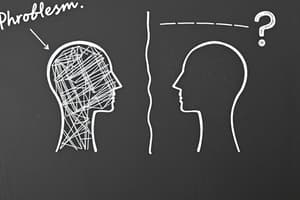Podcast
Questions and Answers
What is the purpose of the scoring rubric introduced by Tay, Quek, Toh, Dong, and Ho (2007) in problem-solving lessons?
What is the purpose of the scoring rubric introduced by Tay, Quek, Toh, Dong, and Ho (2007) in problem-solving lessons?
- To assess problem-solving skills based on Polya's model and Schoenfeld's framework (correct)
- To assess memorization skills
- To evaluate creativity in problem-solving
- To encourage group work in problem-solving
In the 'mathematical practical' introduced by Tay, Quek, Toh, Dong, and Ho (2007), what does the component 'Heuristics' assess?
In the 'mathematical practical' introduced by Tay, Quek, Toh, Dong, and Ho (2007), what does the component 'Heuristics' assess?
- The student's ability to memorize formulas
- The student's typing speed in solving problems
- The student's use of problem-solving strategies like drawing diagrams or working backwards (correct)
- The student's ability to guess answers without solving problems
What does the 'Extending' component in the 'mathematical practical' introduced by Tay, Quek, Toh, Dong, and Ho (2007) evaluate?
What does the 'Extending' component in the 'mathematical practical' introduced by Tay, Quek, Toh, Dong, and Ho (2007) evaluate?
- The student's ability to solve problems without writing anything down
- The student's performance in sports activities during math class
- The student's ability to shorten their solution
- The student's ability to extend their solution to more complex or related problems (correct)
Which of Polya's stages is evaluated by the 'Check' component in the problem-solving lessons introduced by Tay, Quek, Toh, Dong, and Ho (2007)?
Which of Polya's stages is evaluated by the 'Check' component in the problem-solving lessons introduced by Tay, Quek, Toh, Dong, and Ho (2007)?
How were students encouraged to approach problem-solving classes in the 'mathematical practical' introduced by Tay, Quek, Toh, Dong, and Ho (2007)?
How were students encouraged to approach problem-solving classes in the 'mathematical practical' introduced by Tay, Quek, Toh, Dong, and Ho (2007)?
Flashcards are hidden until you start studying
Study Notes
Problem-Solving Lessons
- Introduced the "mathematical practical" concept in 2007 by Tay, Quek, Toh, Dong, and Ho.
- Students are encouraged to treat problem-solving classes as mathematics "practical" lessons.
Scoring Rubric
- Designed to assess problem-solving skills based on Polya's model and Schoenfeld's framework.
- Evaluates student's ability in four components: Check, Polya's Stages, Heuristics, and Extending.
Check Component
- Examines student's ability to check their solution for accuracy and reasonableness.
Polya's Stages Component
- Evaluates student's ability to understand the problem, devise a plan, carry out the plan, and reflect on the solution.
Heuristics Component
- Assesses student's use of problem-solving strategies, such as:
- Drawing diagrams
- Making a list
- Working backwards
Extending Component
- Evaluates student's ability to extend their solution to more complex or related problems.
Studying That Suits You
Use AI to generate personalized quizzes and flashcards to suit your learning preferences.



